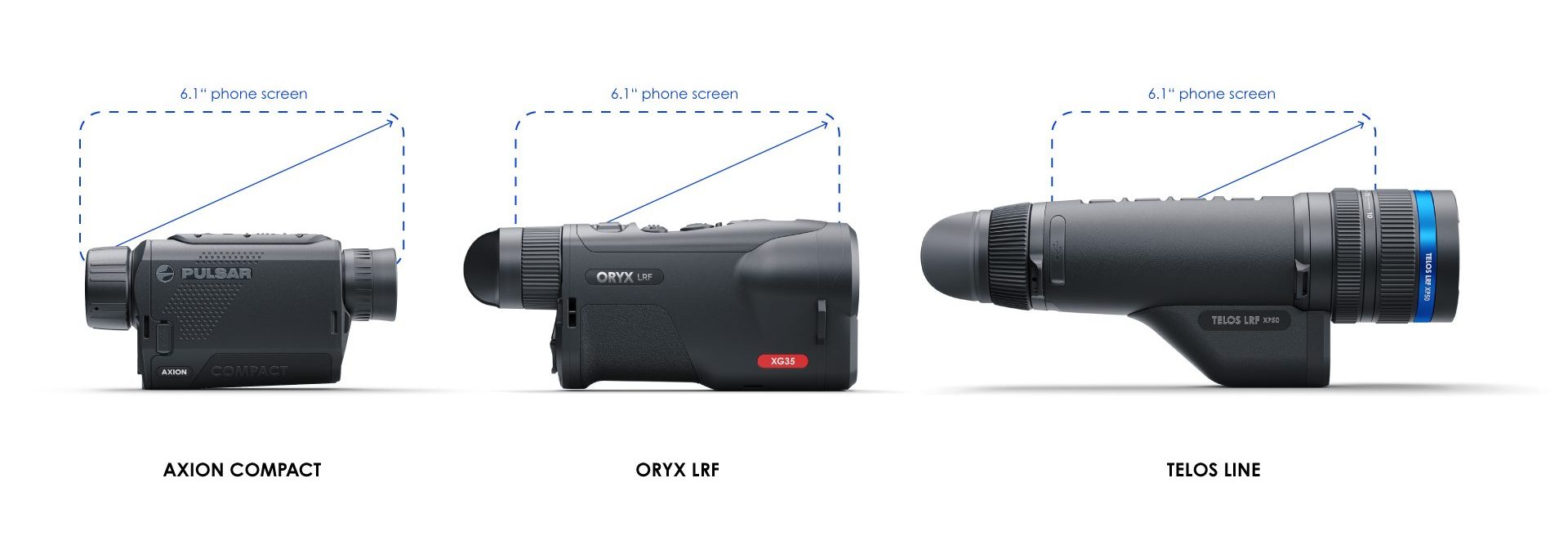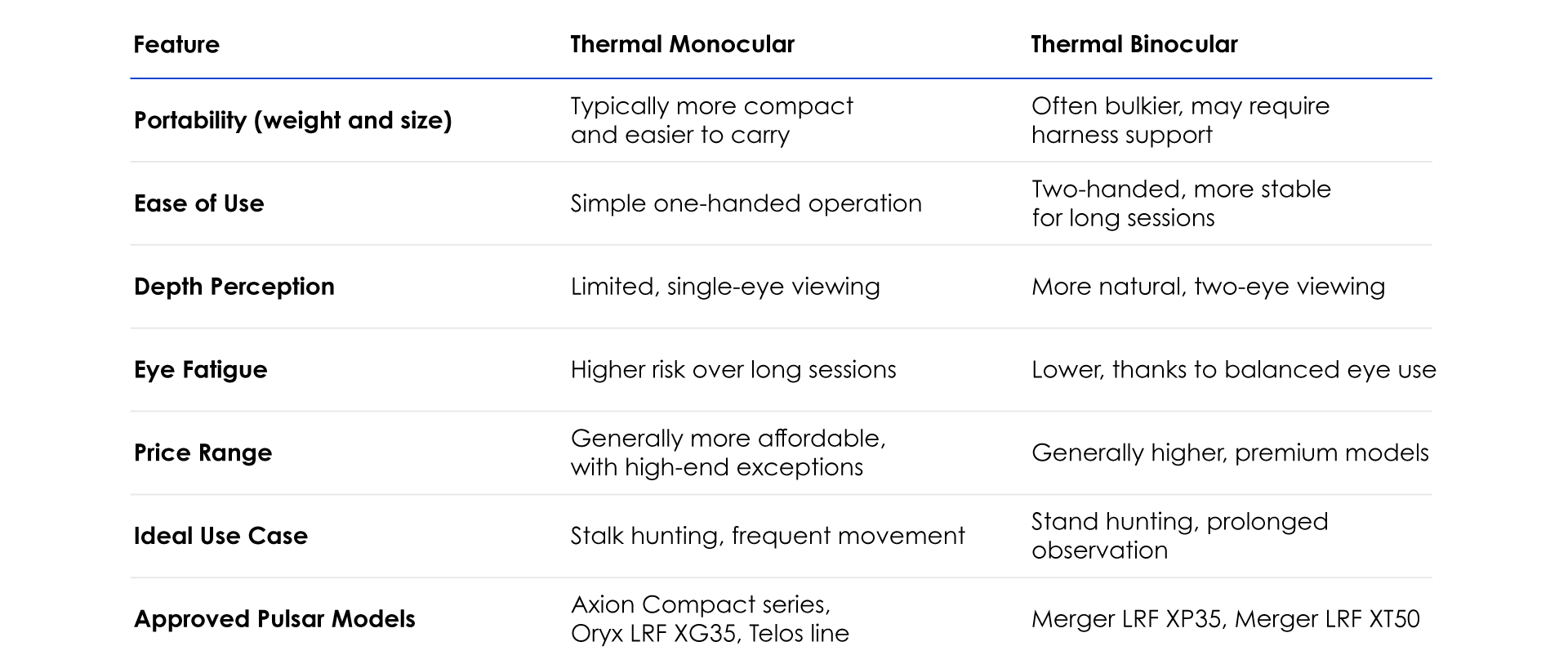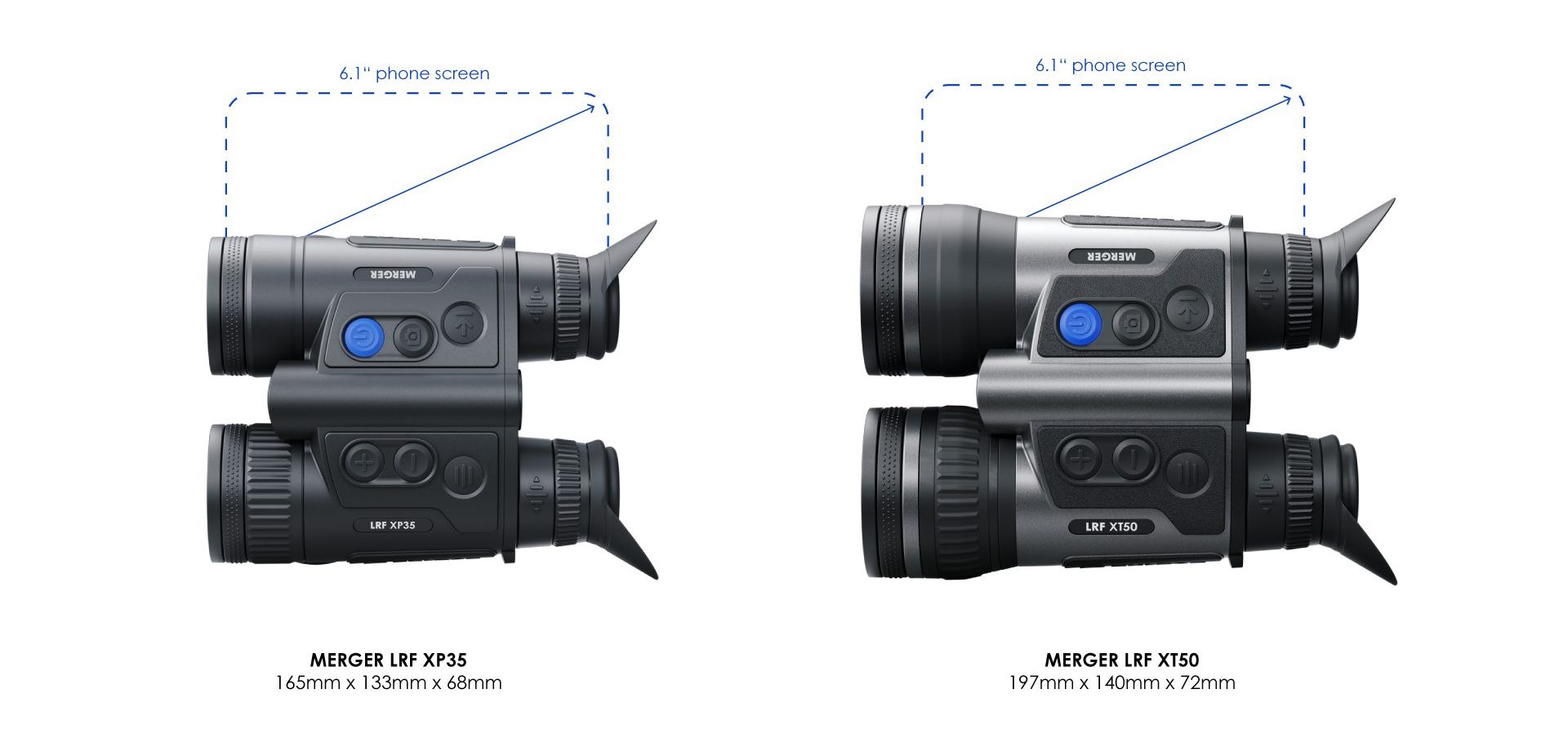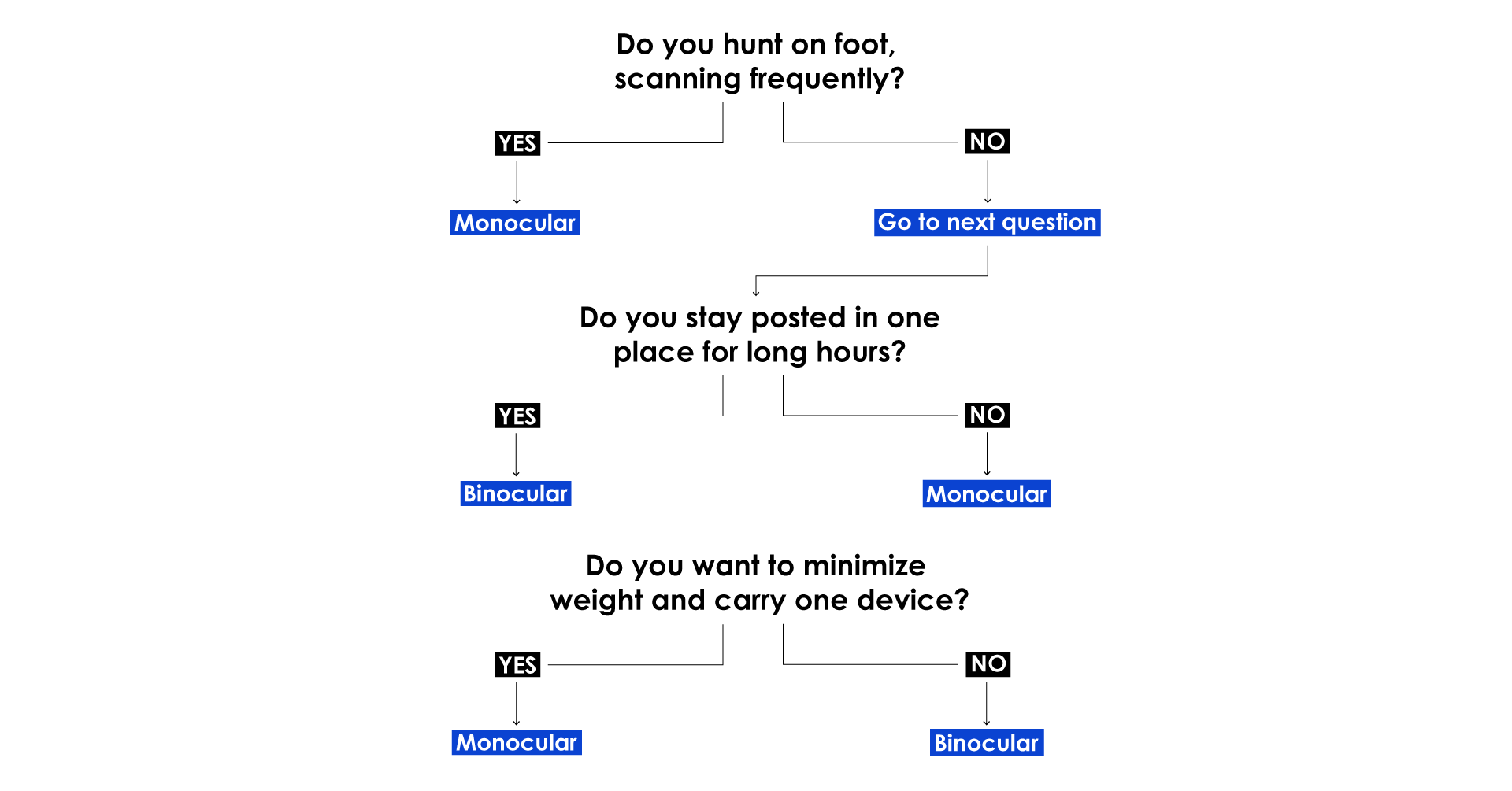Featuring:
Freya Askjaer
Quick Answer:
When comparing thermal monoculars to binoculars, monoculars typically offer lighter, more budget-friendly portability that suits hunters on the move, while binoculars provide immersive, fatigue-reducing observation for extended glassing. The best choice depends on whether you prioritize scanning efficiency for stalk hunting or long-term comfort and depth perception for stand hunting.
Are thermal monoculars or binoculars the better choice for modern hunters? The rise of advanced thermal optics has sparked a debate among those who rely on field-tested performance for spotting game in challenging conditions.
In this guide, we’ll compare thermal imaging monocular vs binoculars, explaining their core differences, advantages, and limitations for hunters with beginner to mid-level experience. You’ll discover which type of device best supports your hunting style, whether you’re scanning on the move during stalk hunting or glassing patiently from a stand.
Expect clear, practical advice backed by Pulsar’s trusted approach to innovation and real-world testing — so you can make an informed, confident decision in your next thermal purchase.
Monoculars vs Binoculars: The Core Difference
A thermal monocular is a single-lens thermal optic that shows heat signatures through one eyepiece, allowing hunters to scan large areas quickly while on the move.
In comparison, a thermal binocular uses two eyepieces to provide a more immersive, comfortable viewing experience, sometimes with enhanced depth cues similar to how human vision naturally perceives distance. This stereoscopic effect — meaning a sense of three-dimensional depth — can help with judging distances and identifying targets more accurately during longer observation sessions.
In the field, monoculars are typically favored by stalk hunters who value fast scanning, thanks to their more compact design and lighter handling. Binoculars often suit stand hunters best, where extended, steady observation benefits from reduced eye fatigue and a more natural viewing style.
But don’t just take our word for it: take it from Freya Askjaer, a Danish huntress with hunting experience in various countries all over the world.
“While scouting for deer in the cold morning mist, I compared a thermal monocular to binoculars — and the difference was clear. The monocular was lightweight and quick to detect roe deer moving through dense cover, while the binoculars provided sharper detail and better depth perception in open fields.
In the forest, I preferred the monocular for its agility, but once I stepped into the open, the binoculars’ magnification and thermal clarity became invaluable — especially for spotting roe deer at greater distances.”
Related: Thermal And Night Vision Devices: Everything You Need To Know
Pros and Cons of Thermal Monoculars
Thermal monoculars are versatile tools that allow hunters to quickly scan, detect, and track heat signatures with a single hand, making them well-suited for dynamic situations in the field. While they typically balance portability and price well, certain advanced models can be larger and more premium-priced.
Pros of Thermal Monoculars
- Typically lightweight and easy to carry
- Allow one-handed operation for better mobility
- Simplify quick scanning during stalk hunting
- Often more budget-friendly than binoculars
- Broad product range, from compact to high-end options
Cons of Thermal Monoculars
- Single-eye viewing may cause fatigue over long periods
- Limited depth perception compared to binoculars
- Can require frequent eye-switching to reduce strain
- Advanced models (e.g., Telos LRF XL50) may lose the “compact” advantage
Real-Life Use Case
So, technicalities aside, in what real-life situations will a hunter benefit from a monocular like the Pulsar Axion XG35 Compact or Oryx LRF XG35? Here’s how our expert hunter Freya uses hers:
“Using the Pulsar thermal monocular fastened to my chest rig under the canopy of the forest at night, I was amazed — it consistently revealed critters moving through the brush and larger deer moving quietly around me. Its lightweight, hands‑free setup makes it a go‑to for any dusk or pre‑dawn outing.
The Axion is compact, instinctive to use, and perfect for scanning during slow stalking when the light is low and the terrain demands patience.”
Quick summary: If you hunt in dense brush or narrow paths, a monocular makes it easier to stay agile and maintain your line of sight without losing your shooting position.
Explore our professional hunters reviews of their favorite monoculars:
Pros and Cons of Thermal Binoculars
Thermal binoculars provide a more natural, immersive viewing experience by engaging both eyes, which reduces fatigue and supports easier depth estimation during long observation periods. This makes them ideal for hunters who stay stationary, such as stand hunters.
Pros of Thermal Binoculars
- More natural two-eye viewing experience
- Reduced eye strain over prolonged use
- Improved perception of distance and spatial awareness
- Better suited for scanning wide open areas or stationary glassing
- Increased comfort during extended hunting sessions
Cons of Thermal Binoculars
- Typically heavier and bulkier than monoculars
- Less convenient for one-handed use
- Higher price points for premium features
- May be less practical for dynamic stalk hunting
Real-Life Use Case
What exactly are the situations where observational comfort is more important than slightly heavier weight? One of them is stand hunting: when you’re monitoring large open meadows during dusk hours, the benefit from thermal binoculars like the Pulsar Merger LRF XP35 will be great. This model supports extended glassing with reduced eye fatigue, ensuring targets are clearly identified even in fading light.
For the Danish huntress Freya Askjaer, they’re irreplaceable in between seasons, too:
“During the pre-hunting season, one session in the wide, frost-coated fields of Jutland proved just how well the Pulsar thermal binoculars perform. When glassing a field or open area with little to no vegetation, they excelled — quickly detecting heat sources and helping me identify the type of animal I was seeing.
What struck me most — beyond the sharp thermal image — was the sheer comfort. The classic binocular design allowed me to glass for extended periods without eye strain or the one-sided fatigue I often get with a monocular. Where long, patient observation is key, the Merger’s ergonomic build made all the difference.”
Field Warning: Consider the added weight of binoculars if you plan to carry them for long distances on foot — they can become tiring without proper harness support.
Related: Thermal Binoculars: A Powerful Tool For Hunters And Nature Explorers
Explore our professional hunters reviews:
Choosing the Right Device for Your Hunting Style
The best thermal device for you depends on your hunting method, the terrain, and how long you typically observe targets. Hunters who move frequently and value quick scanning often benefit from a monocular, while hunters who prefer steady, prolonged observation will generally find binoculars more comfortable and efficient.
Hunting Style Guidance
- Stalk hunters in dense forests or mixed woodland usually gain more flexibility with a monocular, which supports rapid scanning and agile movement.
- Stand hunters in open terrain or fields often prefer binoculars for their comfortable, immersive viewing experience during longer waits.
- In transitional hunting (some movement, some stationary glassing), a higher-end monocular with advanced features like a built-in LRF can balance both needs.
Decision Shortcut
If you’re tracking on foot through a tight cover, a monocular usually fits best. If you hunt from a stand overlooking fields, binoculars are the better pick.
Seasonal & Experience Variations
- Winter hunts: Binoculars can help distinguish subtle heat differences in snow-covered ground thanks to more comfortable long-duration viewing.
- Beginner hunters: May prefer monoculars for simplicity, lower price points, and lighter handling.
- Expert hunters: Often appreciate the immersive experience of binoculars, especially for identifying multiple targets over wide terrain.
Field Scenario Example
A hunter in early spring, shifting between moving through thickets and glassing across open pastures, might find a compact monocular like the Pulsar Axion XQ30 Pro Compact best for balancing scanning speed and moderate observation needs. Huntress Freya Askjaer explains:
“For me, the choice between a thermal monocular and binoculars always comes down to the type of hunt and the terrain. When I’m stalking through dense woodland or moving between stands, I prefer the lightweight flexibility of a monocular — it’s quick to grab and easy to pack. But when I’m in open fields or sitting for hours in a high seat, binoculars give me the comfort and depth I need to scan wide areas for roe deer or foxes without straining my eyes.”
Related: Learn why Telos is the ultimate thermal imaging monocular
Conclusion & Next Steps
Thermal monoculars and binoculars each serve a clear purpose in the modern hunter’s toolkit. Monoculars typically deliver lighter, more agile scanning capabilities, making them well-suited for stalk hunters covering large, varied terrain. Binoculars, by contrast, offer more natural, fatigue-reducing observation for stand hunters who rely on long hours of patient glassing.
Ultimately, the right choice depends on how you hunt, what terrain you cover, and how long you need to stay on target. Think about whether fast scanning or immersive comfort matters more for your personal hunting style.
Explore Pulsar’s lineup of field-tested thermal monoculars and binoculars to find the perfect match for your next hunt.
Frequently Asked Questions (FAQ)
1. Are thermal monoculars good for hunting?
Yes, thermal monoculars are excellent for hunting, particularly for stalk hunters who need to scan quickly and move through variable terrain. They combine portability with powerful heat-detection capabilities, making them a practical choice for mobile hunters.
2. Do thermal binoculars really help with depth perception?
Thermal binoculars offer a more immersive viewing experience and can improve your sense of spatial awareness. While they don’t produce true stereoscopic 3D like daylight binoculars, engaging both eyes reduces strain and helps estimate distance more naturally.
3. Which Pulsar monocular is best for stalk hunting?
Hunters who value compactness and fast scanning often choose the Pulsar Axion XQ30 Pro Compact or Axion XG35 Compact. These models balance detection range and portability, making them ideal for agile movement in wooded terrain.
4. Are thermal binoculars too heavy for field use?
Thermal binoculars, like the Pulsar Merger LRF XP35, are generally heavier than monoculars. However, with proper harness systems, many hunters find them manageable even during extended stand hunting sessions.
5. Can I use thermal monoculars in snowy or rainy conditions?
Yes, most modern thermal monoculars, including Pulsar models, are designed with weather resistance in mind. Be sure to check the IP rating to ensure your device can handle wet or snowy conditions reliably.
6. Is a monocular or binocular better for a beginner hunter?
Beginner hunters often start with a monocular because it is simpler to use, more budget-friendly, and easier to carry. However, if long observation periods are expected, a binocular may reduce eye fatigue.
7. Do thermal binoculars require calibration?
Like most thermal optics, thermal binoculars may require periodic calibration (also called “NUC” — non-uniformity correction) to maintain a clear image. The process is quick and built into Pulsar devices for ease of use.
About the Expert
Expert Contributor:
Freya Askjaer
Freya Askjaer is a Danish huntress living in Sicily, with over a decade of experience hunting across the world.
She has tested Pulsar optics in snow-covered mountains, thick brush, and desert-like areas through every season.
Before purchasing any night or thermal vision device, please make sure you adhere to the local legislation and only use it when it is allowed. Our ambassadors come from various countries and travel a lot, which allows them to test different devices. We do not encourage or support the illegal use of our devices in any events. If you wish to learn more about export and sales restriction policy, please visit the following link: Export and Sales Restriction Policy.





